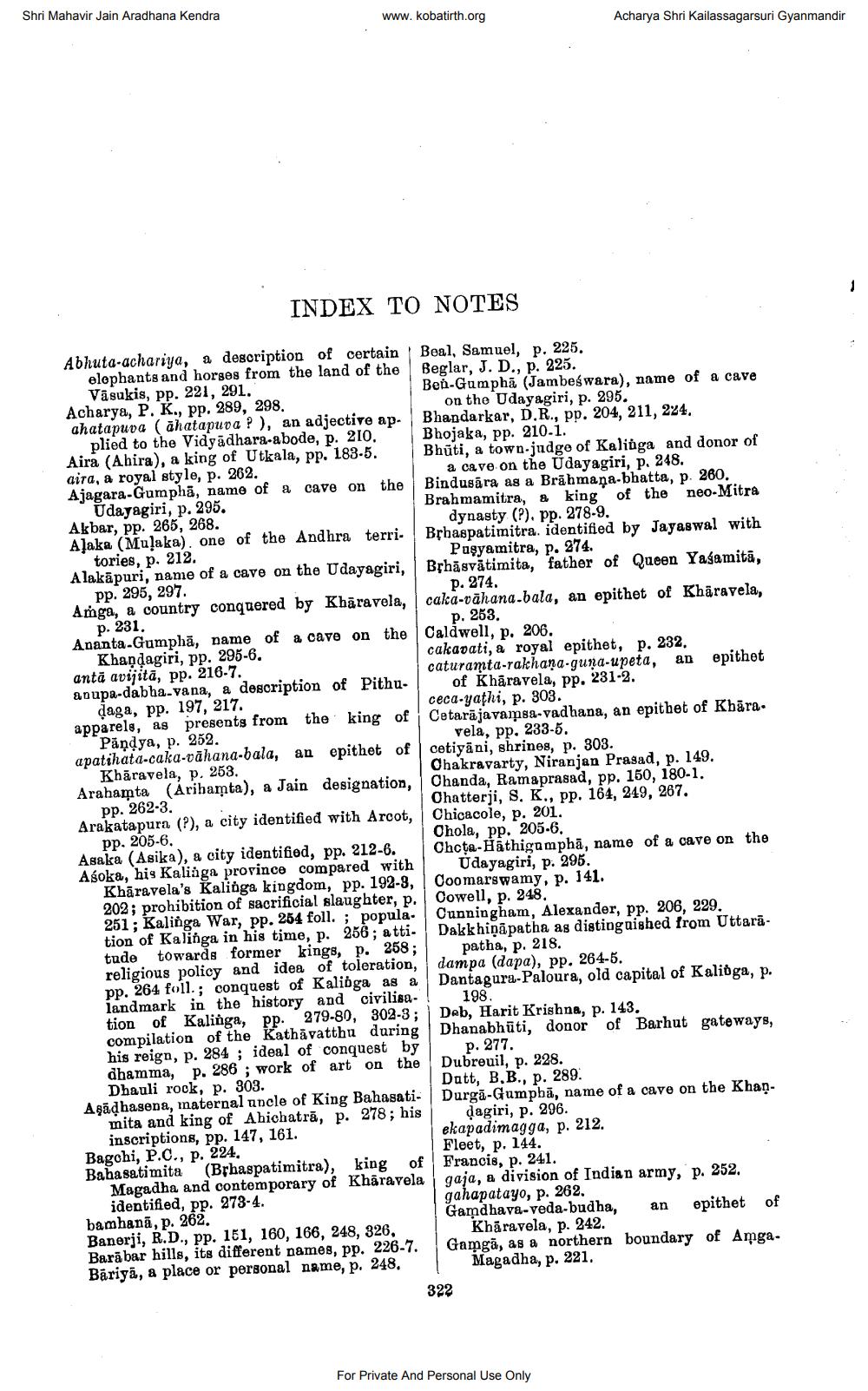________________
Shri Mahavir Jain Aradhana Kendra
www.kobatirth.org
Acharya Shri Kailassagarsuri Gyanmandir
INDEX TO NOTES
Abhuta-achariya, a description of certain Beal, Samuel, p. 225.
elephants and horges from the land of the Beglar, J. D., p. 225. Vasukis, pp. 221, 291.
Ben-Gumphā (Jambeswara), name of a cave Acharya, P. K., pp. 289, 298.
on the Udayagiri, p. 295. ahatapuva (āhatapuva ? ), an adjective ap- Bhandarkar, D.R., pp. 204, 211, 224,
plied to the Vidyadhara-abode, p. 210. Bhojaka, pp. 210.1. Aira (Ahira), a king of Utkala, pp. 183-5. Bhūti, a town-judge of Kalinga and donor of aira, a royal style, p. 262.
a cave on the Udayagiri, p, 248. Ajagara-Ġumphā, name of a cave on the Bindusara as a Brāhmana-bhatta, p. 260. Udayagiri, p. 295.
Brahmamitra, & king of the neo-Mitra Akbar, pp. 265, 268.
dynasty (?), pp. 278-9. Alaka (Mulaka). one of the Andhra terri- Bphaspatimitra. identified by Jayaswal with tories, p. 212.
Paşyamitra, p. 274. Alakāpuri, name of a cave on the Udayagiri, Byhāsvātimita, father of Queen Yagamitā, pp. 295, 297.
p. 274. Amga, a country conquered by Khāravela, caka-vāhana-bala, an epithet of Khāravela, p. 231.
p. 263. Ananta Gumphā, name of a cave on the Caldwell, p. 206. Khaņdagiri, pp. 295-6.
cakaoati, a royal epithet, p. 232. antă avijitā, pp. 216.7.
caturamta-rakhana-guna-upeta, an epithet anupa-dabha.vana, a description of Pithu. of Khāravela, pp. 231-2. daga, pp. 197, 217.
ceca-yathi, p. 303. apparels, as presents from the king of Cetarājavamsa-vadhana, an epithet of Kbāra. Pandya, p. 252.
vela, pp. 233-5. apatihata-caka-vähana-bala, an epithet of cetiyāni, shrines, p. 303. Khāravela, p. 253.
Chakravarty, Niranjan Prasad, p. 149. Arahamta (Arihamta), a Jain designation, Ohanda, Ramaprasad, pp. 150, 180-1. pp. 262-3.
Ohatterji, S. K., pp. 164, 249, 267. Arakatapura (?), a city identified with Arcot, Chicacole, p. 201. pp. 205-6.
Ohola, pp. 205-6. Asaka (Asika), a city identified, pp. 212-6. Chcta-Häthigamphā, name of a cave on the Agoka, his Kalinga province compared with Udayagiri, p. 295.
Khāravela's Kalinga kingdom, pp. 192-3, Coomarswamy, p. 141. 202; prohibition of sacrificial slaughter, p. Cowell, p. 248. 251; Kalinga War, pp. 264 foll. ; popula. Cunningham, Alexander, pp. 206, 229. tion of Kalinga in his time, p. 256; atti. Dakkhiņā patha as distinguished from Uttaratude towards former kings, p. 258; patha, p. 218. religious policy and idea of toleration, dampa (dapa), pp. 264-5. pp. 264 foll.; conquest of Kalibga as a Dantagura-Paloura, old capital of Kalibga, p. landmark in the history and civilisa-! 198. tion of Kalinga, pp. 279-80, 302-3; Deb, Harit Krishna, p. 143. compilation of the Kathāvatthu during Dhanabhūti, donor of Barhut gateways, his reign, p. 284 ; ideal of conquest by p. 277. dhamma, p. 286 ; work of art on the Dubreuil, p. 228. Dhauli rock, p. 303.
Dutt, B.B., p. 289. Agādhasena, maternal uncle of King Bahasati- Durgã-Gumpbā, name of a cave on the Khan
mita and king of Abichatrā, p. 278; his dagiri, p. 296. inscriptions, pp. 147, 161.
ekapadimagga, p. 212. Bagchi, P.C., p. 224
Fleet, p. 144. Bahasatimita (Brhaspatimitra), king of Francis, p. 241.
Magadha and contemporary of Khāravela gaja, a division of Indian army, p. 252. identified, pp. 273-4.
gahapatayo, p. 262. bamhanā, p. 262.
Gamdhava-veda-budha, an epithet of Banerji, R.D., pp. 161, 160, 166, 248, 326,
Khāravela, p. 242. Barā bar hills, its different names, pp. 226-7. Gamgā, as a northern boundary of AmgaBāriyā, a place or personal name, p. 248. Magadha, p. 221.
322
For Private And Personal Use Only




